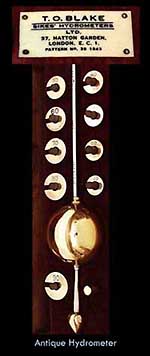
Terms we often hear that are other ways to view the
"same thing" are specific gravity and density.
In a nutshell, it is the amount of dissolved solids in the
water, and now most commonly referred to as a parts per
thousand (ppt) measurement which measures just the salt
amongst those solids.
As a measure of specific gravity (S.G.), or density,
it refers to how much saltier the water is than freshwater;
and it is usually about 1.021-1.025 times as salty as freshwater.
In ppt (of just the salts) it is 32 ppt to 38 ppt usually.
These measures can vary with temperature, and equipment.
We make some recommendations about salinty (S.G.)
on our "Curing Live Rock" page. It is very important
to realize that the figures given there are for curing
your live rock only, not for running a tank.
Since you will throw away curing water rather quickly,
a couple times often, there is no sense in making it as
salty as you can. It won't make a difference during
curing to run it a bit lighter than you will your tank,
just as we suggest running it cooler during curing than
most tanks should be run at, if possible (to keep ox levels high).
Many people think there is a perfect the one and only right
salinity in which to run a tank.
Here are some expert opinions from a few books that fell off
the shelf on proper salinty (as S.G. or density) to keep your
tank at, which are recommended as averages to keep the
most things we reefers keep:
Baensch 1.021
Prasek 1.023
Tullock 1.023
Thiel 1.024
Burgess 1.025
Moe 1.020 to 1.026
There is no "one and only" specific gravity or salinity.
Beware of those who say that about any aspect of husbandry!
 Remember too, all seas are not the same. The Red Sea is
much saltier than any other running 1.027-1.030, so a tank
for those fish should be run at a higher salinity than one
for Indo-Pacific which runs 1.021-1.025 or so. The Carribean
and Florida are saltier than the Indo-Pacific, if you keep a
tank for those animals.
Remember too, all seas are not the same. The Red Sea is
much saltier than any other running 1.027-1.030, so a tank
for those fish should be run at a higher salinity than one
for Indo-Pacific which runs 1.021-1.025 or so. The Carribean
and Florida are saltier than the Indo-Pacific, if you keep a
tank for those animals.
I will quote Moe who says:
"In actual practice, you needn't get all
in a dither about salinity. I don't think that
the salinity of a marine aquarium must be any one particular
value withing a range of 28 to 36 ppt, (1.020 to 1.026).
With the possible exception of certain invertebrates, marine
animals and biological filters do better at salinities lower
than oceanic sea water. Lower salinities keep more
oxygen in the water, allow the nitrifying bacteria to work
more efficiently, and reduce the metabolic work load
of the fish. It is entirely possible to maintain a
beautiful tropical marine aquarium at salinities of 20 to 25 ppt
instead of 30 to 35 ppt."
He goes on to say 33 to 35 ppt is probably best as an overall
average for you to keep a reef tank at.
You should have some of Moe's books!
(See our "Recommended Reading" page.)
He was a true pioneer in this.
One point is that fish-only tanks may benefit more
from lower salinity, and reef tanks (with corals, inverts, etc.)
like the higher end of the scale.
For all of history, the fish wholesalers at LAX run
at the light end of the scale, for the reasons mentioned
by Moe, and because they are either shipping out or throwing
away thousands of gallons a week. That gets expensive fast.
Many retail stores run at the light side for fish, and higher
for coral and invert systems too.
And you thought you had a salt bill? 
In any case, all the authors are all correct. There is
more than one way to skin a catfish. The salinity will not
be the determining factor of your success. Other aspects
of good husbandry (or wifery) will be far more important.
Keeping whatever salinity value (or temperature, etc.) you
choose constant and steady is much more important than
which you choose. I have kept tanks everywhere on
the scale, with success. A couple times I must admit,
I kept tanks that were off the scale !!

~birdfish
Prasek 1.023
Tullock 1.023
Thiel 1.024
Burgess 1.025
Moe 1.020 to 1.026